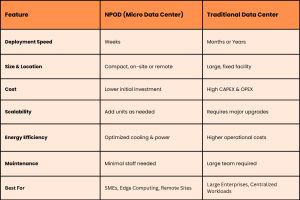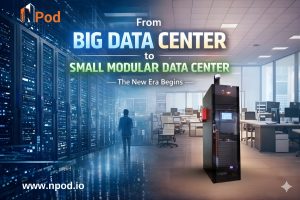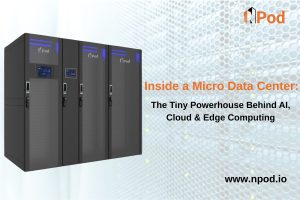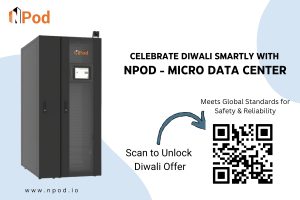Businesses rely significantly on data in today’s rapidly evolving digital world, from storing vital information to executing apps and ensuring seamless operations. For their IT infrastructure, businesses used to depend on sizable, centralized traditional data centers. However, a new solution—the NPOD—has surfaced in response to changing business needs. Read our detailed comparison on nPod vs. traditional data centers to understand which architecture offers better scalability and cost-efficiency for the future. Businesses’ approaches to data processing, storage, and security are being revolutionized by NPOD. Whether you manage a small business or a large corporation, the decision between an NPOD and a traditional data center can significantly affect scalability, performance, and cost.
With a focus on Micro Data Center Solutions India by NetForChoice, we will examine what NPOD is, how it varies from a traditional data center, and why it might be the best option for your company in this blog.
What is NPOD / Micro Data Center?
A Micro Data Center (NPOD) is a small, self-contained, modular data infrastructure unit. An NPOD can be placed exactly where you need it in a matter of weeks, as opposed to large facilities that take months or years to construct.
Within a single, pre-engineered enclosure, it houses all of the necessary parts of a full-scale data center, including servers, storage, networking hardware, cooling, and power systems. It is therefore ideal for:
- Processing data near its source is known as edge computing.
- Remote areas where it is impractical to construct a sizable facility
- Companies that require rapid IT infrastructure deployment
What is a Traditional Data Center?
Large, centralized facilities that store, handle, and process enormous volumes of data for one or more organizations are known as traditional data centers. These facilities need significant infrastructure investment and frequently cover thousands of square feet, including:
- Several server racks
- Intricate cooling systems
- A power source with a large capacity
- Committed employees on-site
Even with their strength and capacity to manage massive workloads, traditional data centers have a high CAPEX (Capital Expenditure), lengthy setup times, and little flexibility in terms of location changes.
NPOD vs Traditional Data Center—The Key Differences

Benefits of NPOD for Businesses
- Faster Implementation
Businesses can quickly establish IT infrastructure without having to wait months for construction and configuration due to NPOD units, which can be set up in a matter of weeks.
- Lower Prices
Businesses can avoid significant upfront costs by using a pay-as-you-grow strategy. Because of the automation and smaller footprint, maintenance is also less expensive.
- Edge Computing Ready
For real-time applications like AI, IoT, and video analytics, Edge Computing Ready NPOD allows data processing near the source, reduces latency, and enhances performance.
- Flexibility & Scalability
Do you require additional processing or storage capacity? There is no need for extensive renovations; simply add another NPOD module.
- Efficiency in Energy
Reduced energy consumption from improved cooling and power systems supports green initiatives and lowers utility costs.
- Enhanced Security
To safeguard sensitive data, NPODs have integrated cybersecurity, environmental monitoring, and access control.
Why Businesses Are Moving from Traditional Data Centers to NPOD
Businesses require distributed and adaptable IT infrastructure as a result of the shifting business landscape brought about by remote work, IoT devices, and AI-driven workloads. Large-scale operations will always find a place in traditional data centers, but NPOD provides:
- Mobility: Set up anywhere, even in isolated locations.
- Speed: Quickly set up and begin operations.
- Control costs by only paying for what you use.
- Performance: Bring data closer to the users.
NetForChoice NPOD: Micro Data Center Solutions in India
With its NPOD platform, NetForChoice provides cutting-edge micro data center solutions in India. Organizations of all sizes can benefit from NetForChoice NPOD’s optimal performance, security, and flexibility.
Key Features of NetForChoice NPOD
- Tier III & IV Data Center Standards’ salient features
- Adaptable Design: Constructed to meet your precise specifications
- Constant Monitoring and Assistance
- Options for Hybrid Power: Including Solar Integration for Remote Locations
- Multi-Layer Security: Digital and physical security measures
Which Should You Choose—NPOD or Traditional Data Center?
Choose NPOD if
- You must deploy quickly.
- Your activities are spread all over several sites.
- You wish to reduce the initial outlay of funds.
- For real-time applications, local processing is required.
Choose a Traditional data center if
- You manage large, centralized workloads.
- You have the funds for extensive infrastructure.
- You need a long-term, large-capacity facility.
Conclusion
Your company’s size, objectives, and infrastructure requirements will determine which option—NPOD or traditional data center—is best for you. NPOD/micro data center solutions are the way to go for the majority of modern companies looking for cost-effectiveness, scalability, and flexibility.
NetForChoice’s Micro Data Center Solutions in India provide the ideal balance of speed, security, and performance to satisfy your expanding IT needs if you’re searching for a reliable supplier in India.
FAQs
- Can traditional data centers be replaced by NPOD?
Yes, for some workloads. Large businesses may still require traditional data centers for centralized operations, but NPOD is perfect for edge computing, remote deployments, and scalable solutions.
- Are NPODs secure?
Yes, multi-layer physical and cyber security measures are included with NPODs to ensure high data protection.
- How soon can an NPOD be deployed?
The majority of NPOD arrangements can be put into use in a few weeks.




